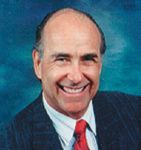Article
Interim results of hyperopic LASIK trial highly favorable
Atlanta—Interim study analyses from a multicenter, North American trial indicate LASIK for treatment of hyperopia with or without astigmatism using the Nidek EC-5000 excimer laser is associated with consistently good safety and efficacy outcomes, reported George O. Waring III, MD, the medical monitor for the study.

The study is under way at seven clinical sites, Dr. Waring explained.
A total of 144 eyes with spherical hyperopia and 149 eyes with hyperopic astigmatism were entered into the trial, and 168 eyes have been examined at the 6-month visit.
Patients enrolled in the EC-5000 study had to have normal topography, stable refraction over the past 12 months, and be a candidate for a bilateral procedure. The allowed ranges of refractive error were between 0.50 and 6 D for sphere and 0.50 to 3 D for cylinder. The actual MRSE range of treatment was 0.50 to 6.687 D with the cylinder values ranging from 0.50 to 2.375 D.
Treated for distance All eyes were treated for distance correction using a 6-mm optical ablation zone and 9-mm transition ablation zone. Operating parameters were fixed at each investigational site with no nomogram adjustments.
At the 6-month follow-up visit, 109 (64.9%) of the 168 eyes evaluated achieved an uncorrected visual acuity (UCVA) of 20/20 or better. Rates of UCVA of 20/25 or better were achieved by 86.3% and 20/40 or better by 98.8%.
"Although the FDA has no benchmarks for criteria for hyperopic LASIK, the FDA criteria for myopic LASIK require that 85% of eyes achieve UCVA of 20/40 or better; and the unofficial target for 20/20 is 50%. The results with the Nidek EC-5000 clearly surpass those benchmarks," Dr. Waring said.
The refractive predictability outcomes at 6 months also exceeded the FDA requirements for myopic LASIK: manifest spherical equivalent refraction (MRSE) was within 0.5 D of attempted in nearly three-quarters of eyes (120/169; 71%); 94.7% were within ±1 D, and in no eye was the MRSE >2 D of attempted. FDA criteria suggest that MRSE be within ±0.50 D in 50% of eyes and ±1 D in 75%.
The best spectacle-corrected visual acuity (BSCVA) analyses showed that only 3% (5/168) of the eyes lost 2 or more lines of BSCVA; the FDA benchmark is <5%. Among the 155 eyes seen at 6 months that had BSCVA 20/20 or better preoperatively, only one (0.7%) had BSCVA worse than 20/25 at 6 months. The FDA criterion is <1%.
Dr. Waring also compared the Nidek EC-5000 study data with results from the FDA trials for the Technolas laser (Bausch & Lomb), LADARVision (Alcon Laboratories), STAR (AMO/VISX), and Allegretto (WaveLight Laser Technologie AG) lasers using information taken from the FDA Web site. Although the composition of the various study populations varied with respect to treatment ranges for both sphere and cylinder and the Nidek study has fewer eyes, the results with the EC-5000 results were at least as good if not superior to those achieved with the other systems.
"Most notably, the 65% rate of UCVA of 20/20 or better achieved in this study was higher than that reported at 6 months postoperatively in the Technolas (61.4%), LADARVision (43.3%), and STAR (48.1%) clinical trials, and the Nidek study has the lowest rate of loss of ≥2 lines of BSCVA," Dr. Waring observed.
Newsletter
Don’t miss out—get Ophthalmology Times updates on the latest clinical advancements and expert interviews, straight to your inbox.




